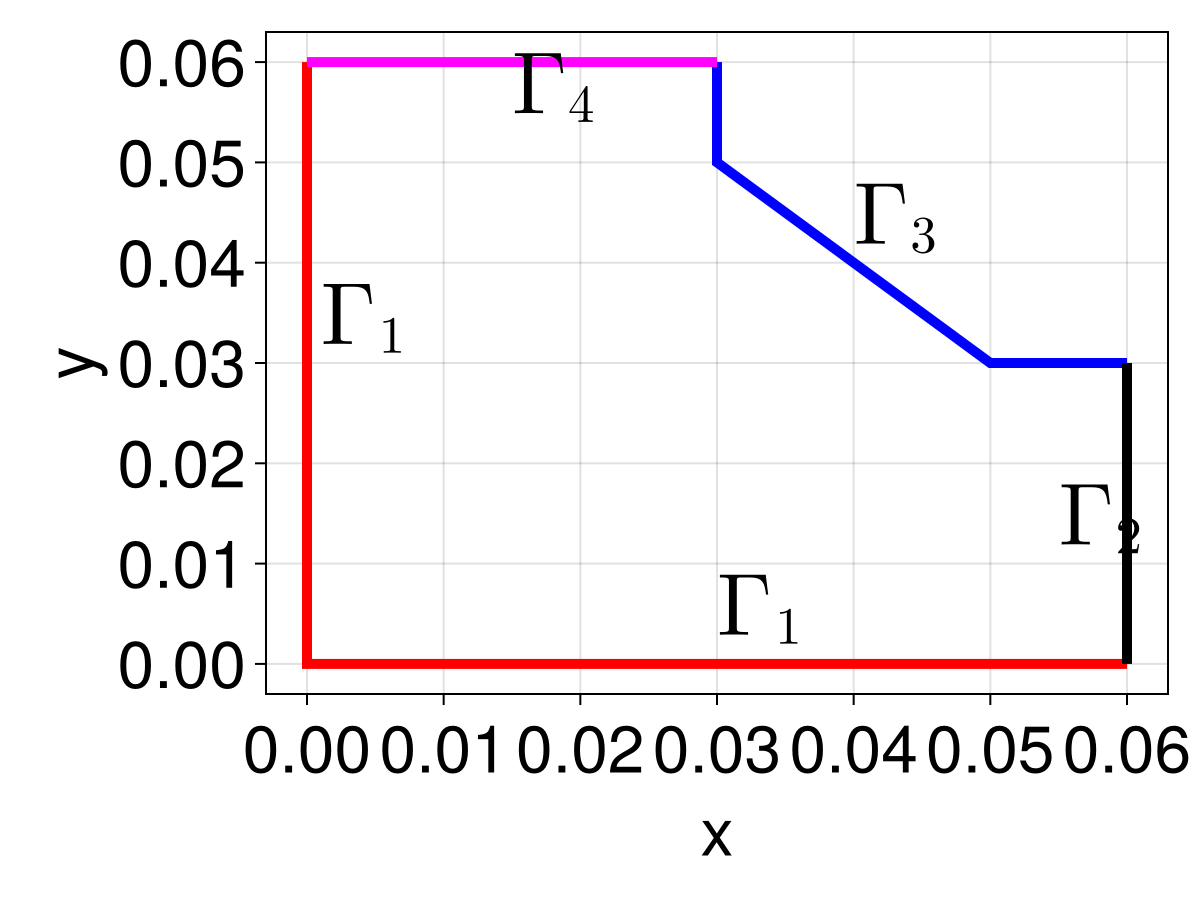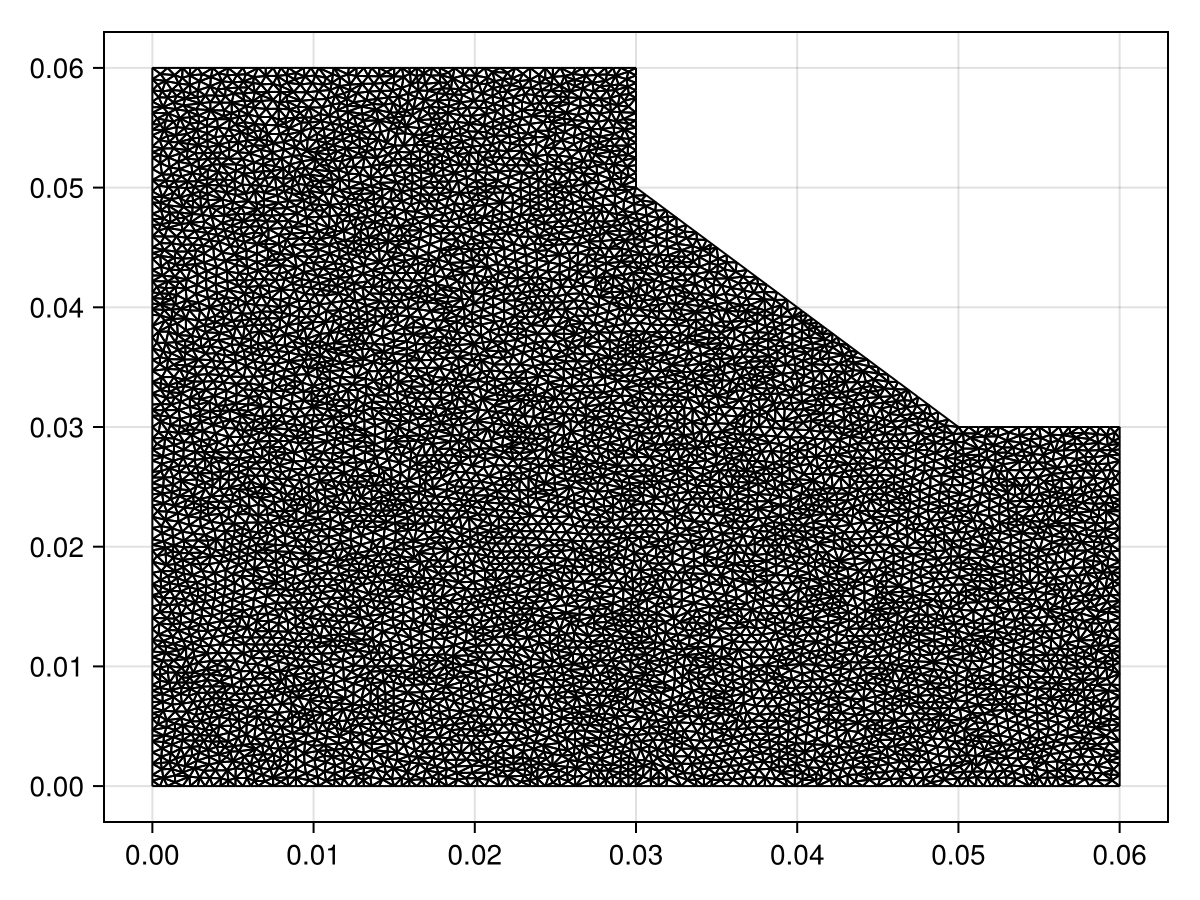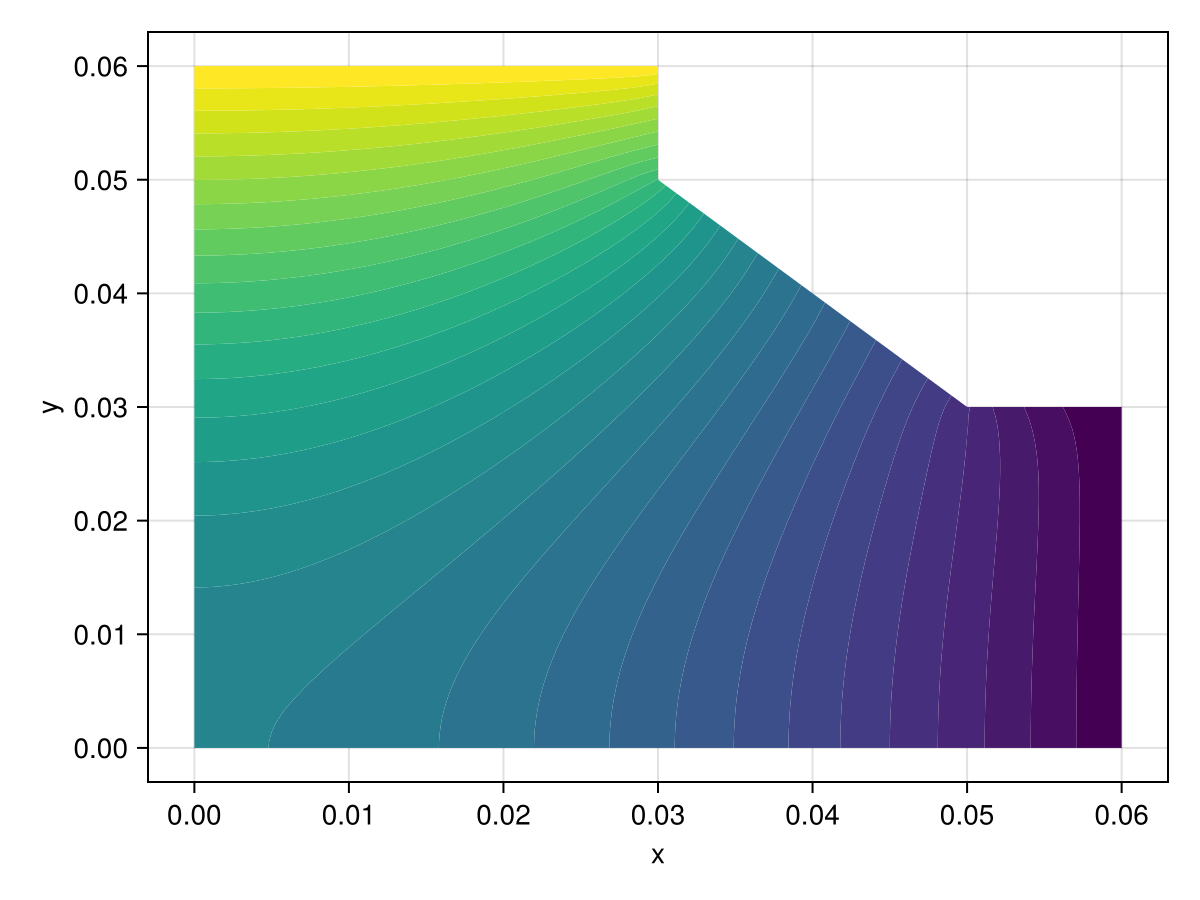Equilibrium Temperature Distribution with Mixed Boundary Conditions and using EnsembleProblems
For this tutorial, we consider the following problem:
\[\begin{equation} \begin{aligned} \grad^2 T &= 0 & \vb x \in \Omega, \\ \grad T \vdot \vu n &= 0 & \vb x \in \Gamma_1, \\ T &= 40 & \vb x \in \Gamma_2, \\ k\grad T \vdot \vu n &= h(T_{\infty} - T) & \vb x \in \Gamma_3, \\ T &= 70 & \vb x \in \Gamma_4. \\ \end{aligned} \end{equation}\]
This domain $\Omega$ with boundary $\partial\Omega=\Gamma_1\cup\Gamma_2\cup\Gamma_3\cup\Gamma_4$ is shown below.

Let us start by defining the mesh.
using DelaunayTriangulation, FiniteVolumeMethod, CairoMakie
A, B, C, D, E, F, G = (0.0, 0.0),
(0.06, 0.0),
(0.06, 0.03),
(0.05, 0.03),
(0.03, 0.05),
(0.03, 0.06),
(0.0, 0.06)
bn1 = [G, A, B]
bn2 = [B, C]
bn3 = [C, D, E, F]
bn4 = [F, G]
bn = [bn1, bn2, bn3, bn4]
boundary_nodes, points = convert_boundary_points_to_indices(bn)
tri = triangulate(points; boundary_nodes)
refine!(tri; max_area=1e-4get_area(tri))
triplot(tri)
mesh = FVMGeometry(tri)FVMGeometry with 8144 control volumes, 15944 triangles, and 24087 edgesFor the boundary conditions, the parameters that we use are $k = 3$, $h = 20$, and $T_{\infty} = 20$ for thermal conductivity, heat transfer coefficient, and ambient temperature, respectively.
k = 3.0
h = 20.0
T∞ = 20.0
bc1 = (x, y, t, T, p) -> zero(T) # ∇T⋅n=0
bc2 = (x, y, t, T, p) -> oftype(T, 40.0) # T=40
bc3 = (x, y, t, T, p) -> -p.h * (p.T∞- T) / p.k # k∇T⋅n=h(T∞-T). The minus is since q = -∇T
bc4 = (x, y, t, T, p) -> oftype(T, 70.0) # T=70
parameters = (nothing, nothing, (h=h, T∞=T∞, k=k), nothing)
BCs = BoundaryConditions(mesh, (bc1, bc2, bc3, bc4),
(Neumann, Dirichlet, Neumann, Dirichlet);
parameters)BoundaryConditions with 4 boundary conditions with types (Neumann, Dirichlet, Neumann, Dirichlet)Now we can define the actual problem. For the initial condition, which recall is used as an initial guess for steady state problems, let us use an initial condition which ranges from $T=70$ at $y=0.06$ down to $T=40$ at $y=0$.
diffusion_function = (x, y, t, T, p) -> one(T)
f = (x, y) -> 500y + 40
initial_condition = [f(x, y) for (x, y) in DelaunayTriangulation.each_point(tri)]
final_time = Inf
prob = FVMProblem(mesh, BCs;
diffusion_function,
initial_condition,
final_time)FVMProblem with 8144 nodes and time span (0.0, Inf)steady_prob = SteadyFVMProblem(prob)SteadyFVMProblem with 8144 nodesNow we can solve.
using OrdinaryDiffEq, SteadyStateDiffEq
sol = solve(steady_prob, DynamicSS(Rosenbrock23()))retcode: Success
u: 8277-element Vector{Float64}:
70.0
53.103092183130336
40.0
40.0
44.13431924538936
⋮
54.71768793632413
53.77066316067286
53.221394119351224
49.03373489007241
49.984596496529385fig, ax, sc = tricontourf(tri, sol.u, levels=40:70, axis=(xlabel="x", ylabel="y"))
fig
Just the code
An uncommented version of this example is given below. You can view the source code for this file here.
using DelaunayTriangulation, FiniteVolumeMethod, CairoMakie
A, B, C, D, E, F, G = (0.0, 0.0),
(0.06, 0.0),
(0.06, 0.03),
(0.05, 0.03),
(0.03, 0.05),
(0.03, 0.06),
(0.0, 0.06)
bn1 = [G, A, B]
bn2 = [B, C]
bn3 = [C, D, E, F]
bn4 = [F, G]
bn = [bn1, bn2, bn3, bn4]
boundary_nodes, points = convert_boundary_points_to_indices(bn)
tri = triangulate(points; boundary_nodes)
refine!(tri; max_area=1e-4get_area(tri))
triplot(tri)
mesh = FVMGeometry(tri)
k = 3.0
h = 20.0
T∞ = 20.0
bc1 = (x, y, t, T, p) -> zero(T) # ∇T⋅n=0
bc2 = (x, y, t, T, p) -> oftype(T, 40.0) # T=40
bc3 = (x, y, t, T, p) -> -p.h * (p.T∞- T) / p.k # k∇T⋅n=h(T∞-T). The minus is since q = -∇T
bc4 = (x, y, t, T, p) -> oftype(T, 70.0) # T=70
parameters = (nothing, nothing, (h=h, T∞=T∞, k=k), nothing)
BCs = BoundaryConditions(mesh, (bc1, bc2, bc3, bc4),
(Neumann, Dirichlet, Neumann, Dirichlet);
parameters)
diffusion_function = (x, y, t, T, p) -> one(T)
f = (x, y) -> 500y + 40
initial_condition = [f(x, y) for (x, y) in DelaunayTriangulation.each_point(tri)]
final_time = Inf
prob = FVMProblem(mesh, BCs;
diffusion_function,
initial_condition,
final_time)
steady_prob = SteadyFVMProblem(prob)
using OrdinaryDiffEq, SteadyStateDiffEq
sol = solve(steady_prob, DynamicSS(Rosenbrock23()))
fig, ax, sc = tricontourf(tri, sol.u, levels=40:70, axis=(xlabel="x", ylabel="y"))
figThis page was generated using Literate.jl.